
Human resource managers have long sung the praises of regular performance reviews. But even so, this practice is often met with resistance.
That’s mainly because when we think of performance reviews, we tend to picture a strict supervisor sitting across from us, reviewing our progress and setbacks, and discussing what we need to improve.
However, it doesn’t have to be like this.
If conducted right, performance reviews can be an excellent opportunity to have an open, honest, and transparent conversation about our work that will, in the end, make us more satisfied and engaged.
That’s why in this article, we gathered the five most significant reasons why all team leads should regularly hold performance reviews with their teams.
So let’s start!
Table of Contents
To build trust between leadership and developers
The trust of your developers is more important than you might realize.
According to the Edelman Trust Barometer, one in three people don’t trust their employer.
The study also found that employees are less likely to trust their companies as they move down the ranks.
For example, 64% of executives trust their companies, while only 51% of managers and 48% of non-managerial employees stated they do the same.

In other words, employees tend to trust their coworkers more than their bosses.
The higher up the corporate ladder you go, the more challenging it’ll be for you to earn your employees’ trust.
The graph, shown below, summarizes what happens when the trust between leaders and their employees deteriorates.
It causes disengagement, lack of loyalty to the organizations, unwillingness to commit the time and resources to the project, and reluctance to advocate on behalf of the company.

Therefore, building trust between leadership and developers is of great importance, and performance reviews are one of the best tools to achieve that.
If the performance review is conducted in a fair, unbiased, and honest way, it can be a great opportunity for team leads to get some quality one-on-one time with developers, and talk about what they’re working on, how they’re feeling about their work, and where they’d like to grow.

Get unreal data to fix real issues in your app & web.
To build rapport, a performance review should be more like a dialogue than a formal assessment, and team leads should listen carefully, speak clearly and show respect during the process.
Similarly, developers should feel comfortable enough to speak their minds without fear of rebuke.
However, the way you conduct your performance review can make a big difference in how successful it is in achieving trust.
Gergely Orosz, a software engineer and the author of the blog The Pragmatic Engineer, perfectly sums this up in his article Performance Reviews for Software Developers—How I Do Them In a (Hopefully) Fair Way.

According to him, a poorly conducted performance review is discouraging and makes the developers feel like they’re not doing well. Therefore, it destroys trust.
A good performance review has the opposite effect: it’s motivating and encouraging and can go a long way in improving relations between developers and team leads.
To increase employee satisfaction
The majority of employees feel that traditional performance reviews don’t affect their performance in a positive way.
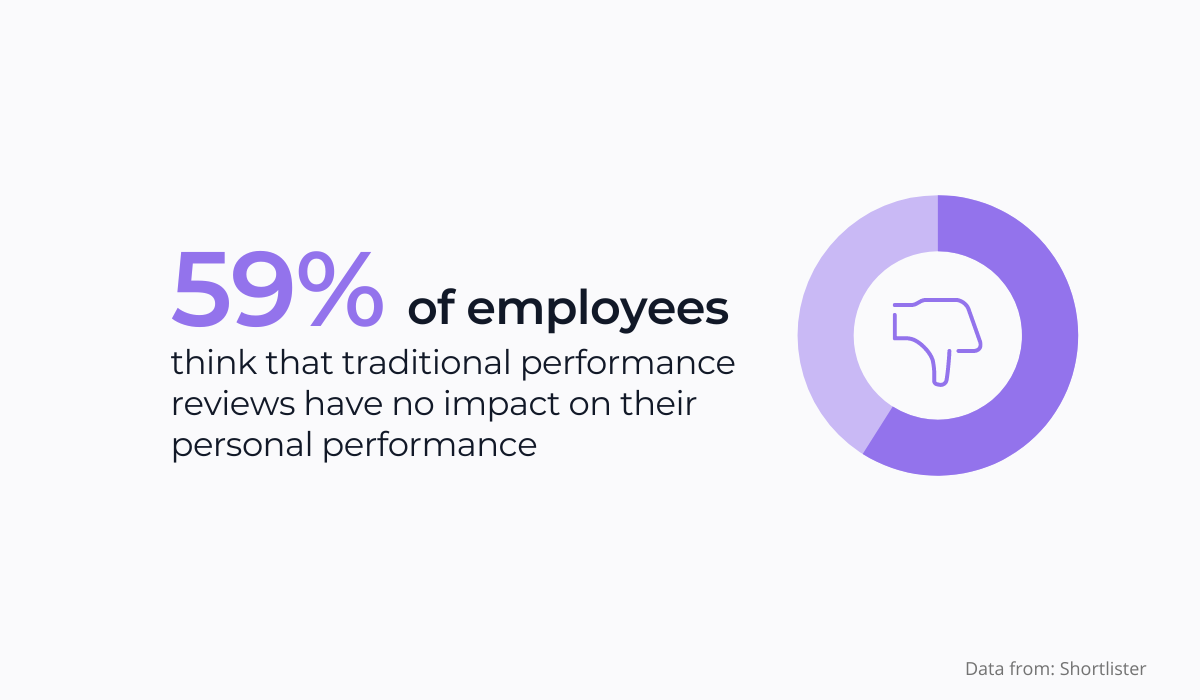
If that is so, what can we do to conduct performance reviews in a way that increases developer satisfaction?
The answer is simple—if conducted right, they can be a great tool for making developers feel motivated, satisfied, and, most importantly, happy at work.
A good performance review gives you a chance to evaluate developers’ strengths and weaknesses and to provide fair, actionable feedback.
This helps developers identify areas for improvement, provides opportunities for growth and increases engagement by creating concrete goals to be achieved.
The problem, as mentioned earlier, is that the majority of the performance reviews are conducted in a traditional way where employees sometimes feel more like they’ve been put on trial rather than having a constructive conversation.
That’s also Gergely Orosz’s experience, who was on the verge of quitting his job after several bad performance reviews.
When he became a manager, he made the firm decision to never have those uncomfortable and cumbersome performance reviews with his subordinates.

Luckily, more and more companies are adopting new approaches, and companies such as Netflix, Adobe, and Microsoft have already moved away from traditional performance assessments.
For example, Adobe completely revamped its performance review system and implemented a practice named Check-ins.
As you can see in the video below, the company decided to get rid of annual reviews and instead have employees regularly meet with their managers to discuss their work and set goals.
This way, every couple of weeks there’s a formal check-in process in place that gives everyone a chance to talk about what’s going well and what could use some improvement.
The managers still give their employees goals and hold them accountable for meeting them—but now the conversation about work happens much more frequently, giving employees a chance to reflect on how they’re doing on an ongoing basis.
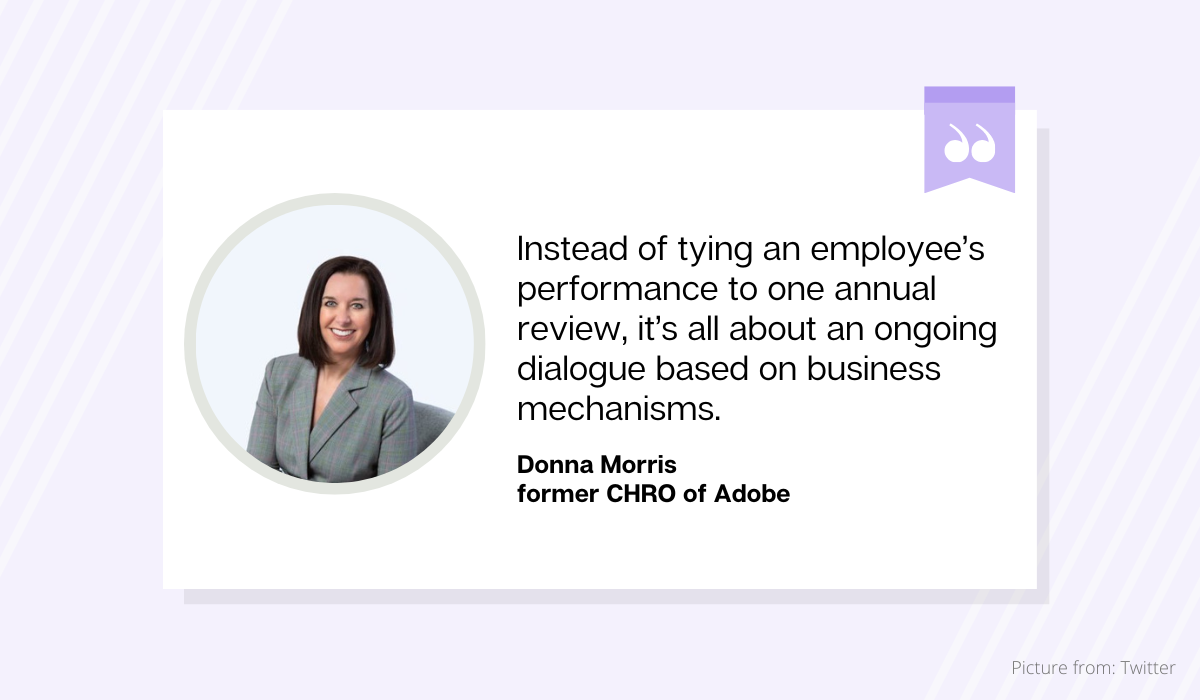
And they’ve seen great results as the voluntary turnover decreased by about 30%.
This actually comes as no surprise given the fact that 68% of employees who received accurate, consistent feedback reported they feel fulfilled in their jobs.
Adobe’s example shows us that performance reviews can be a game-changer when it comes to employee satisfaction.
They lead to more honest communication about performance, as well as less guesswork about how developers are performing.
And that all adds up to the developers’ satisfaction with the job.
To clear up any misunderstandings
A performance review conversation is not only an evaluation but also a time when employees can clear up misunderstandings about their role.
Considering that a staggering 47% of employees aren’t clear about what their role entails and often don’t entirely understand their assignments, responsibilities, and work processes, they can prove to be especially important.

As the graph above shows, role clarity can significantly impact employees’ effectiveness, retention rate, productivity, and satisfaction with the leaders.
And conducting regular performance reviews can be a great way to clarify the duties that come with the role and further explain what is expected of employees in their position.
Performance reviews also offer an excellent opportunity to discuss employees’ development prospects and overall career paths.
If you look at the picture below, you can see an example of a software developer’s career path and the steps that developers must take to advance from junior positions to CTO.
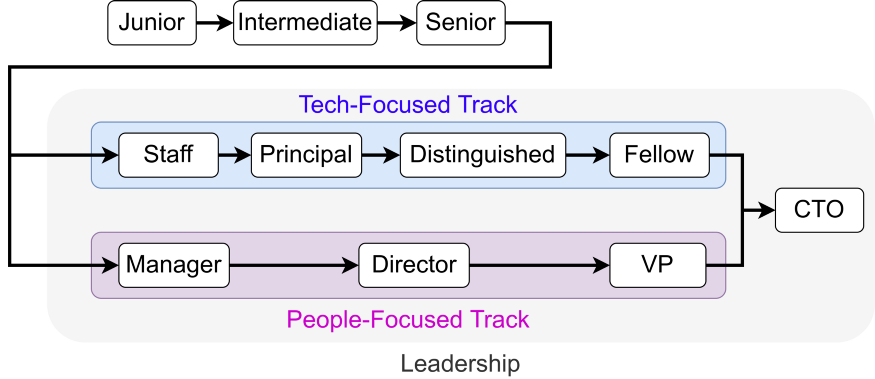
In practice, however, developers often don’t have this kind of clear understanding of their career paths, they’re not aware of various positions that exist in the company and don’t know how they can move up the corporate ladder.
And that misunderstanding can lead to frustration when they feel like they’re not being promoted fairly.
Knowing the steps they need to take to advance in their careers, they can plan for each step upfront, ensuring they gain proper skills and experience for future positions along the way.
Not knowing what’s ahead, they might keep spinning the wheel and not doing the right things they need to get a promotion.
On that note, scheduling regular performance reviews, along with conducting them properly, can help resolve these misunderstandings because developers are now able to ask questions and resolve concerns they might have.
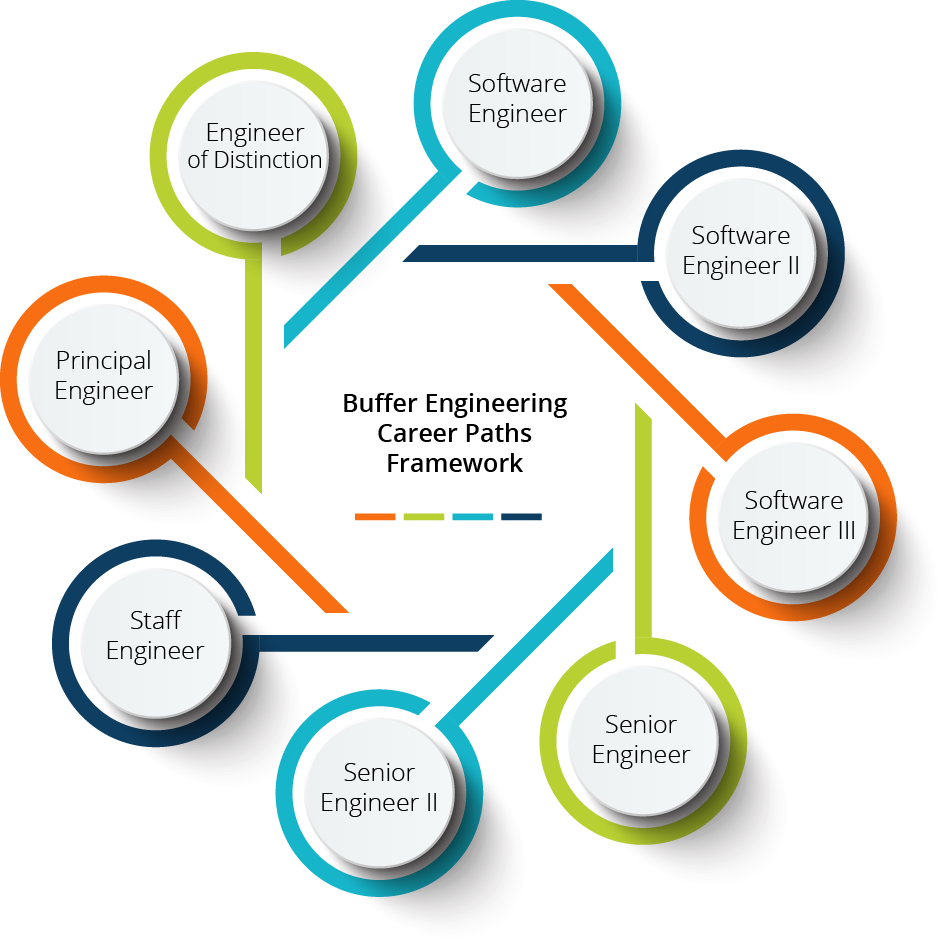
In the picture, you can see Buffer’s career paths framework, which they use to help their employees think about how they want to grow in their careers.
Although this way employees get to know what it takes to move up through the ranks on their own, one-on-one performance reviews are still a good way to go through the details again in case there’s still some confusion or misunderstanding present.
To meet deadlines
As a team lead, it’s important to be proactive when it comes to keeping tabs on the velocity and productivity of your team members.
You want to ensure that your developers are performing at their best—or at least that they’re not missing the deadlines.
So how do you know that your developers are struggling and that a performance review is needed?
Here are some telltale signs:
- Deadlines are consistently being missed
- Requirements are not being captured correctly
- Code quality is poor or inconsistent
- Team members have become increasingly disengaged from their work
A performance review can help you to assess your team members and find out what’s behind their underperformance or missed deadlines.

Developers might be having too much on their plates, causing them to feel stressed out, or even experience burnout.
They might be missing some tools or skills to perform tasks on time.
Or they might simply get stuck in code reviews, thereby not having enough time to move the project forward.
Whatever the reason may be, a performance review will help you identify areas where improvements can be made so that developers become more efficient and consistent in their work.
However, if you only evaluate your team members once every year, then it’s likely you won’t catch any problems that may have arisen during the interim period.
Also, according to a Gallup study, employees who receive weekly feedback are nearly three times more likely to be engaged at work.
Therefore, regular performance reviews should become a part of your new workflow.
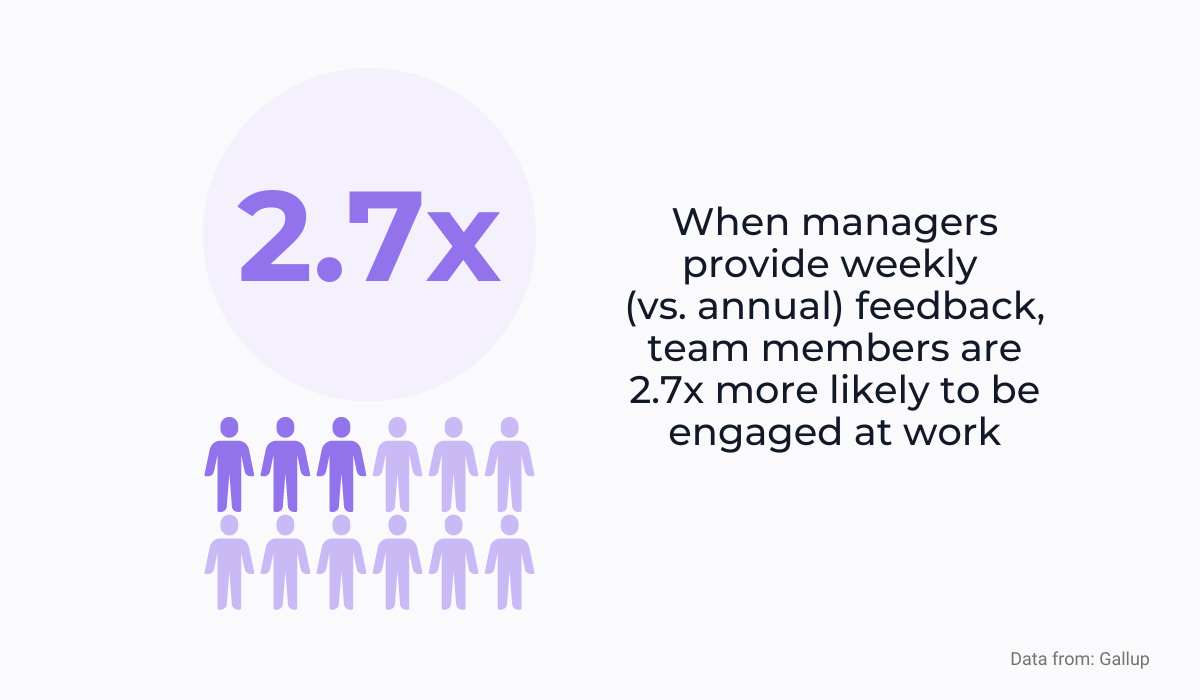
That doesn’t mean you should get rid of the annual review altogether, but rather have more regular assessments to be in the loop with your team’s performance.
For example, Coding Sans recommends that you hold three different kinds of reviews: annual compensation decisions, quarterly or per-project performance snapshots, and weekly check-ins.

This way, employees don’t just get one chance at a review—they’re constantly being evaluated throughout the year, making sure they’re on the right track with their assignments and getting feedback before they become inefficient.
By approaching performance reviews as an opportunity to create mutually beneficial feedback loops with your employees, you’ll be able to get everyone on the same page when it comes to meeting deadlines and improving their overall productivity.
To have more accurate information about your team
Performance reviews can be a great opportunity to collect detailed information about your team’s overall effectiveness.
And one of the best ways to gather this kind of information is through a 360-degree performance review.
As you can see in the picture, a 360-degree performance review is a series of evaluations from different perspectives in the workplace.
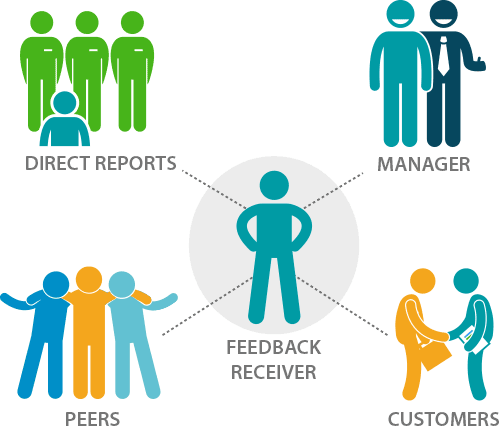
Typically evaluations come from peers, superiors, direct responses, and customers, but you can get more information from any relevant parties involved in an employee’s work.
For example, in the case of a software developer, a 360-degree developer might resemble a situation similar to the one in the rather funny picture below.

The picture clearly shows that, with a 360-degree performance review, you would get a more complete view of your developer’s performance.
As this approach gives you access to feedback from other stakeholders, such as other developers, and members of a product team, you can get a glimpse of how others perceive your developer’s strengths and weaknesses.
And as all team members are involved in the process, you’ll get information about every developer from multiple perspectives, thus getting a better understanding not only of your individual developers but also of your whole team.
Considering these advantages, it’s no wonder Netflix decided to get rid of the formal performance reviews in favor of a culture where employees were encouraged to give and receive continuous feedback.

During the 360-degree reviews, employees at Netflix are requested to name the things their peers should stop, start, or continue doing.
That allows Netflix, and other companies that opted for this type of practice, to get a more accurate picture of an employee’s overall performance, but it also gives them valuable insight into how a team is performing as a whole.
Conclusion
If you want to lead a successful team, your developers should be reviewed regularly and consistently.
Performance reviews help you identify where they’re excelling and needing improvement.
They also provide valuable feedback about productivity and happiness at work and enable you to build better teams.
In this article, we collected the five most significant reasons why regular performance reviews can be beneficial for your team.
Hopefully, they’ll help you develop a solid strategy for your team’s performance evaluation process.





